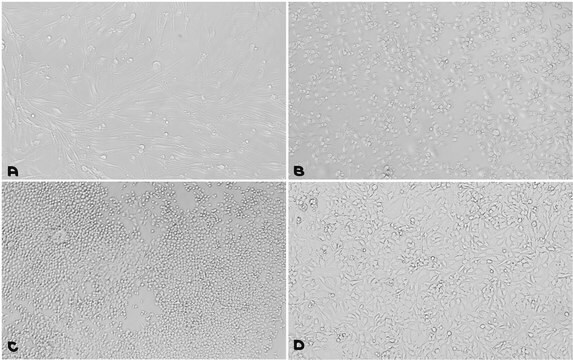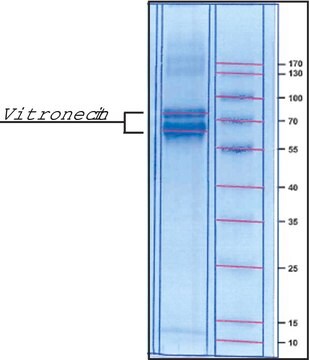F0556
Human Fibronectin
from human fibroblasts, liquid, ~0.5 mg/mL, suitable for cell culture
Sinónimos:
Fibronectin
About This Item
Productos recomendados
product name
Fibronectina, cell culture derived, ~0.5 mg/mL, sterile-filtered, BioReagent, suitable for cell culture
biological source
human fibroblasts
Quality Level
sterility
sterile-filtered
product line
BioReagent
form
solution
mol wt
31 kDa
packaging
pkg of 100 μL
concentration
~0.5 mg/mL
technique(s)
cell culture | mammalian: suitable
impurities
HBSAG, none detected
HCV, none detected
HIV-1/HIV-2, none detected
NCBI accession no.
UniProt accession no.
binding specificity
Peptide Source: Collagen
shipped in
dry ice
storage temp.
−20°C
Gene Information
human ... FN1(2335)
¿Está buscando productos similares? Visita Guía de comparación de productos
General description
Application
- It is used in purification of human extracellular matrix (ECM)
- Coating of tissue culture plates with extracellular matrix components
- Used during cell culture (For xeno-free, feeder-free culture the cells were passaged in to human fibronectin along with other components)
Fibronectin from human plasma can be used with epithelial cells, mesenchymal cells, neuronal cells, fibroblasts, neural crest cells, and endothelial cells. It is recommended for use as a cell culture substratum at 1-5 μg/cm2 or 0.5-50 μg/mL. The optimal concentration does depend on cell type as well as the application and research objectives.
Biochem/physiol Actions
Components
Caution
Preparation Note
Storage Class
11 - Combustible Solids
wgk_germany
WGK 3
flash_point_f
Not applicable
flash_point_c
Not applicable
ppe
Eyeshields, Gloves, type N95 (US)
Certificados de análisis (COA)
Busque Certificados de análisis (COA) introduciendo el número de lote del producto. Los números de lote se encuentran en la etiqueta del producto después de las palabras «Lot» o «Batch»
¿Ya tiene este producto?
Encuentre la documentación para los productos que ha comprado recientemente en la Biblioteca de documentos.
Los clientes también vieron
Artículos
Extracellular matrix proteins such as laminin, collagen, and fibronectin can be used as cell attachment substrates in cell culture.
Protocolos
Dilute fibronectin to the desired concentration. Optimum conditions for attachment are dependent on cell type and application. The typical coating concentration is 1 – 5 ug/cm2.Fibronectin coating protocol, products, and FAQs.
Nuestro equipo de científicos tiene experiencia en todas las áreas de investigación: Ciencias de la vida, Ciencia de los materiales, Síntesis química, Cromatografía, Analítica y muchas otras.
Póngase en contacto con el Servicio técnico








